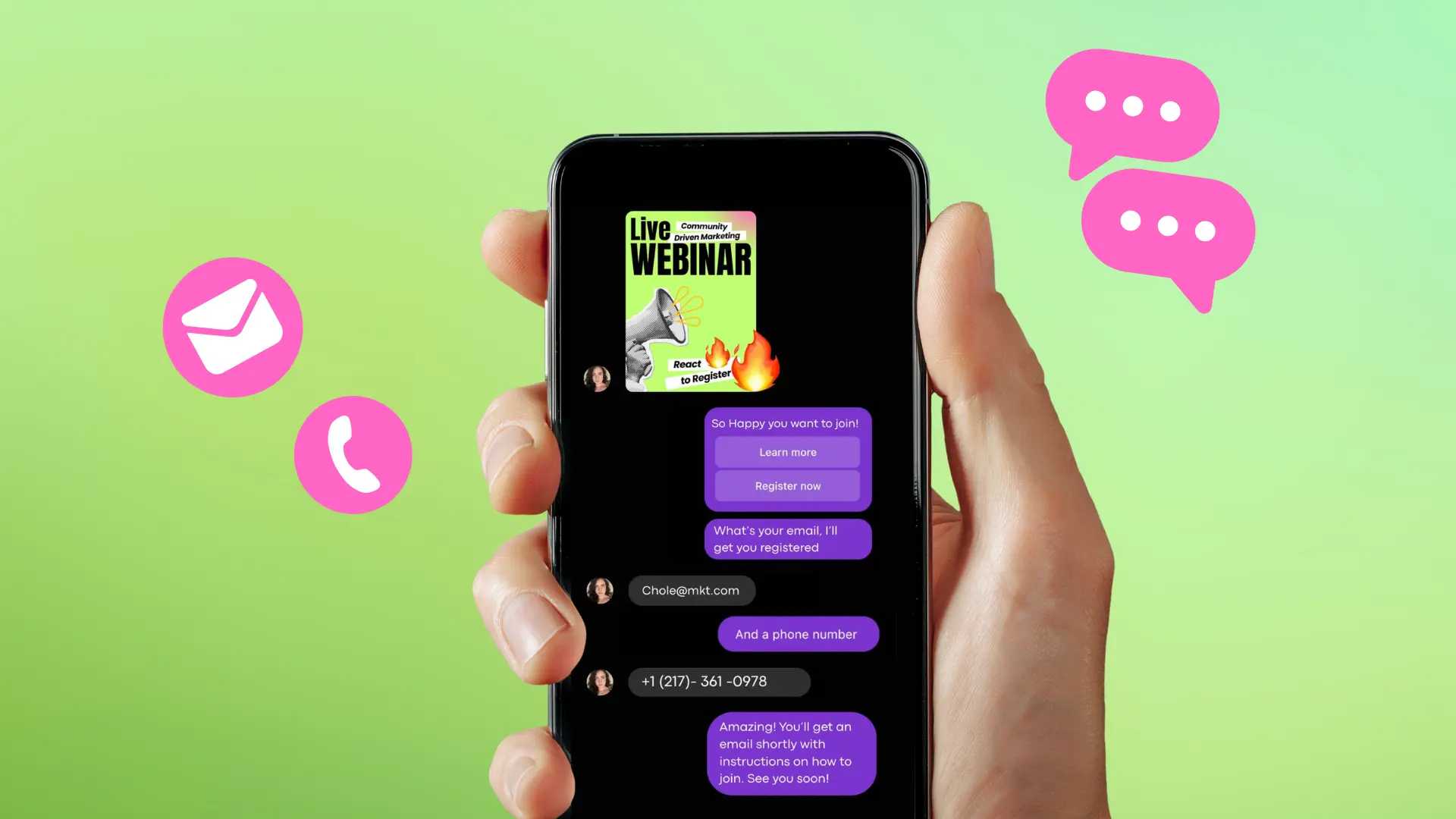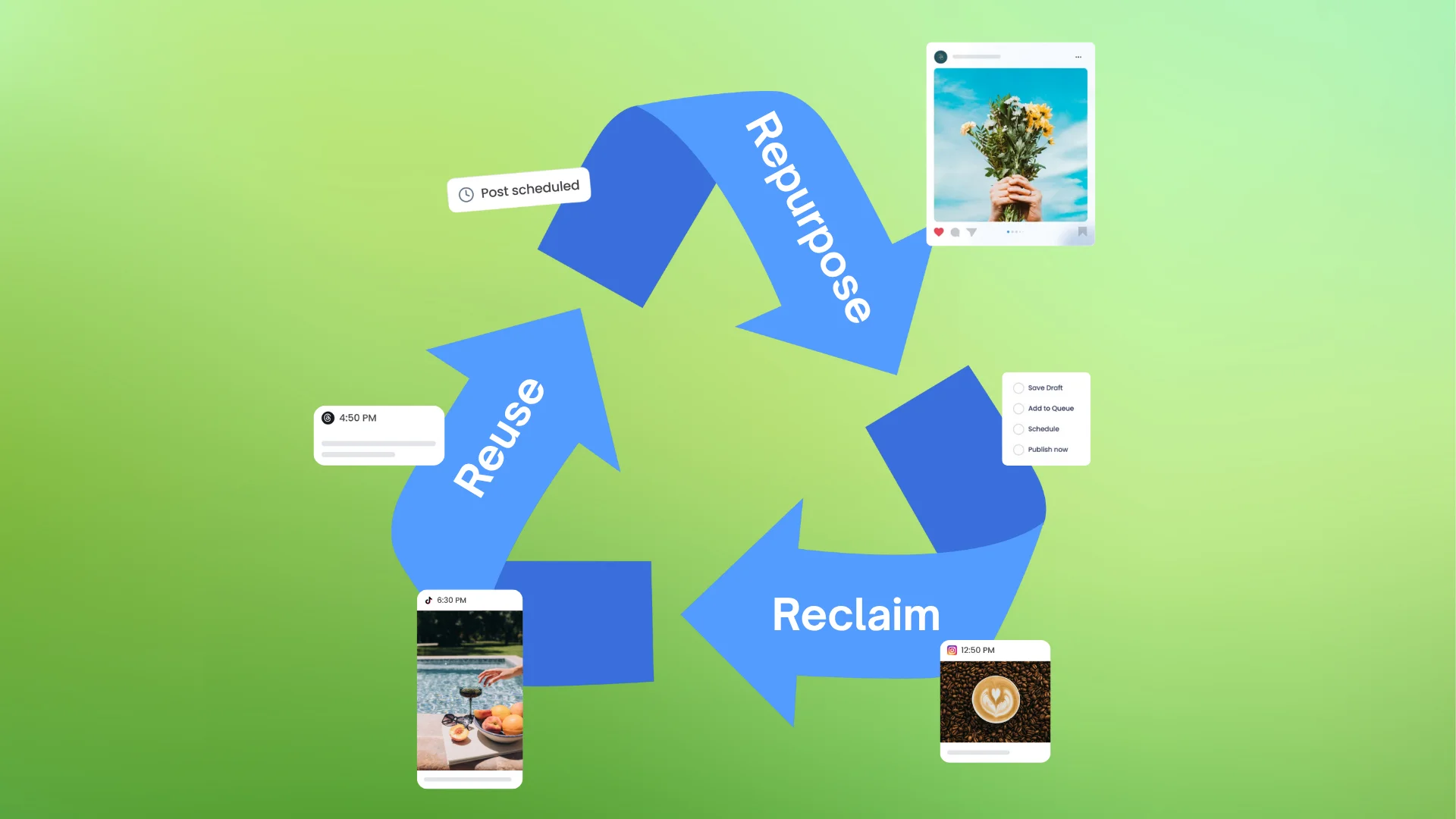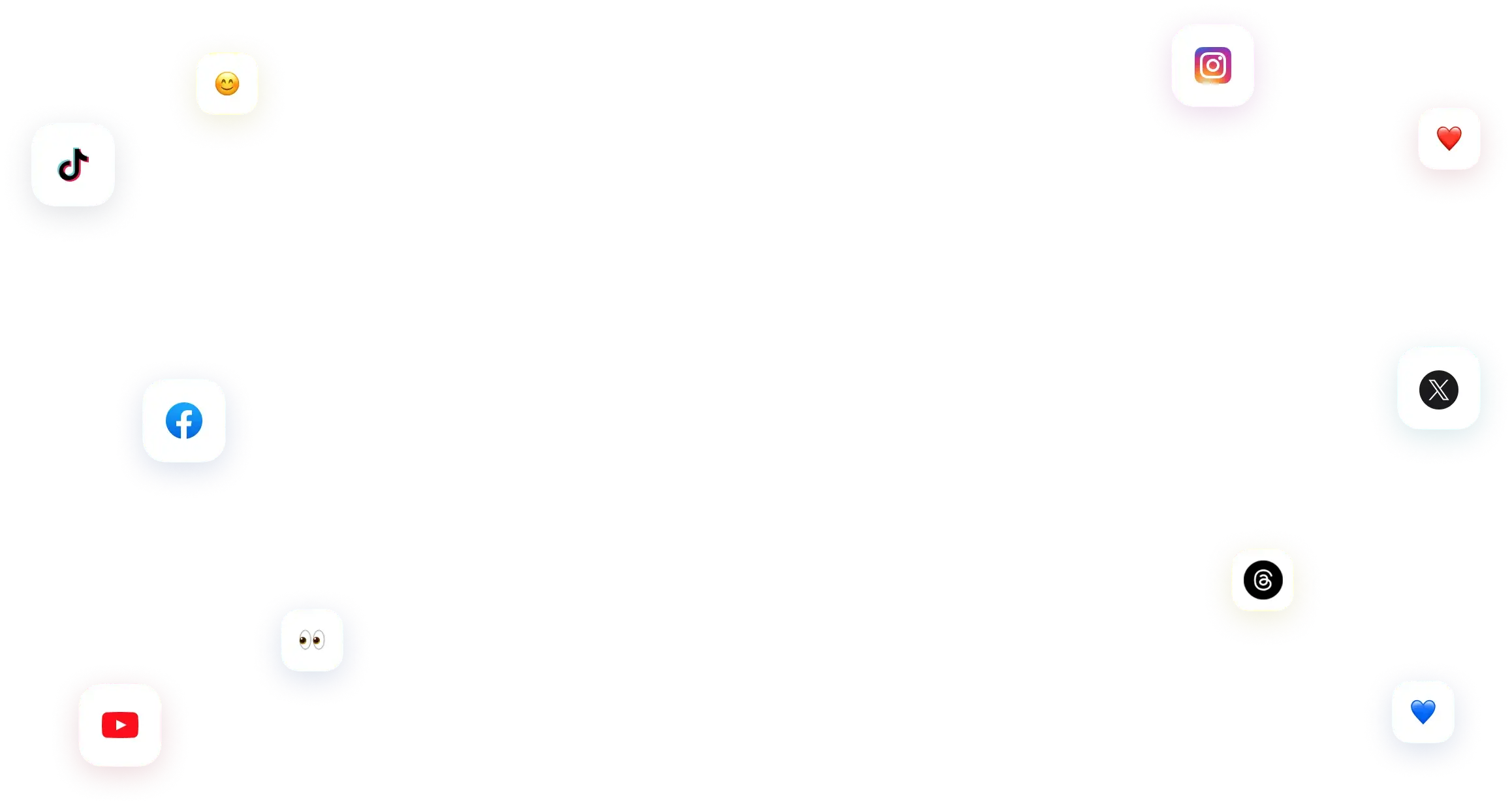New

Turn Your DMs Into Lead Gen!
Learn how to collect lead data from your DMs such as email addresses, phone numbers, and more right from your social inbox. If you are not yet automating your DMs your competitors are outpacing you.

How Something Social Saved 75% of Their Time and Increased Revenue by 15%
See how a fast-growing agency improved operations, cut down hours of manual work, and unlocked new revenue opportunities with Vista Social.
New

50 Unique Social Media Ideas for Consistent Content Creation
Discover 50 unique social media post ideas to engage your audience, grow your brand, and maintain a consistent content strategy with ease!

Mastering Content Reuse: The Key to a Consistent and Sustainable Posting Strategy
Published on August 19, 2025
7 min to read
Why Social Media Manager Burnout is Destroying Teams
Summarize with AI


Table of Content

Your best social media manager just handed in their resignation. Sound familiar? You’re not alone. 73% of marketers experience burnout, and social media manager burnout is hitting teams harder than ever before.
Social media manager burnout isn’t just about feeling tired after a long day. It’s a state of physical, emotional, and mental exhaustion that destroys creativity, productivity, and team morale. When your social media managers burn out, it creates a ripple effect that damages everything from content quality to client relationships.
This guide will show you exactly why social media manager burnout is happening, what it’s costing your business, and most importantly, how to prevent it before it destroys your team.
Table of contents
What is Social Media Manager Burnout?
Social media manager burnout is a specific type of workplace exhaustion that happens when the demands of managing social media consistently exceed a person’s ability to cope. Unlike regular work stress that comes and goes, burnout is a chronic condition that builds up over time.
Here’s what makes social media manager burnout different from other types of work stress. First, social media never sleeps. Your managers feel pressure to monitor comments, respond to messages, and stay on top of trends 24/7. Second, the work is highly visible and public, which means mistakes feel magnified and criticism feels personal.
Warning signs your team should watch for:
- Decreased enthusiasm for creative projects
- Increased cynicism about social media campaigns
- Physical symptoms like headaches and insomnia
- Difficulty concentrating on strategy and planning
- Emotional detachment from work and colleagues
Why are social media roles particularly vulnerable? The combination of creative demands, technical skills, customer service responsibilities, and constant platform changes creates a perfect storm for burnout. Additionally, many businesses still don’t fully understand what social media managers do, leading to unrealistic expectations and inadequate support.
The Hidden Costs of Social Media Manager Burnout
When social media manager burnout hits your team, the costs go far beyond replacing a single employee. Let’s break down what it’s really costing your business.
Team productivity and morale impacts create immediate problems. Burned-out managers work slower, make more mistakes, and need more supervision. Moreover, their negative energy affects the entire team’s motivation and collaboration.
Content quality and campaign performance decline becomes obvious to clients and audiences. Burned-out managers produce generic content, miss trending opportunities, and fail to engage authentically with followers. Consequently, your brand’s social media presence becomes stale and ineffective.
Recruitment and training costs add up quickly. The average cost to replace an employee ranges from 50% to 200% of their annual salary. For social media managers, this includes recruitment fees, onboarding time, and the months it takes new hires to fully understand your brand voice and strategy.
Lost institutional knowledge hurts long-term strategy. When experienced managers leave, they take valuable insights about what works for your audience, relationships with influencers, and understanding of your brand’s social media history.
Finally, brand reputation risks emerge from inconsistent social presence. Delayed responses to customer complaints, missed crisis communications, and off-brand content can damage relationships that took years to build.
Top 5 Causes of Social Media Manager Burnout
Cause 1: Always-On Culture and 24/7 Expectations
Social media manager burnout often starts with unrealistic availability expectations. Many businesses expect their social media managers to monitor accounts around the clock, respond to comments within minutes, and handle crisis communications on weekends.
This always-on mentality creates several problems. First, managers never truly disconnect from work, which prevents proper rest and recovery. Second, the pressure to be constantly available leads to anxiety and stress even during supposed downtime.
Cause 2: Unrealistic Workload and Resource Constraints
Most social media managers are drowning in responsibilities. They’re expected to create content, manage multiple platforms, respond to customer service inquiries, run advertising campaigns, analyze performance data, and develop strategy—often for multiple brands simultaneously.
Furthermore, many teams lack proper tools and support. Managers spend hours on manual tasks that could be automated, like scheduling posts across platforms or compiling performance reports. Without adequate resources, even the most capable managers eventually hit their breaking point.
Cause 3: Constant Algorithm Changes and Platform Updates
The social media landscape changes daily. New features launch, algorithms shift, and trending formats emerge constantly. Social media managers feel pressure to master every update immediately while maintaining performance on existing campaigns.
This constant learning demand is exhausting. Additionally, algorithm changes can tank campaign performance overnight, creating stress and pressure to quickly adapt strategies without adequate time or resources.
[Must Read: Evolution of Social Media Algorithms: A 2025 Guide for Digital Marketers]
Cause 4: Lack of Career Development and Recognition
Many organizations treat social media management as entry-level work, despite requiring advanced skills in marketing, design, copywriting, customer service, and data analysis. This leads to social media manager burnout when talented professionals feel undervalued and see limited growth opportunities.
Moreover, social media work is often misunderstood by leadership. Executives who don’t grasp the complexity of the role may dismiss social media managers’ contributions or set unrealistic expectations based on misconceptions about the work involved.
Cause 5: Measurement Pressure Without Proper Tools
Social media managers face intense pressure to prove ROI and demonstrate results, but many lack the tools to track performance effectively. They spend hours manually compiling data from multiple platforms, creating reports, and trying to attribute business results to social media efforts.
This measurement burden becomes overwhelming when combined with content creation and community management responsibilities. Without proper analytics tools, managers can’t efficiently prove their value, leading to additional stress and job insecurity.
How to Prevent Social Media Manager Burnout
Try Vista Social for Free
A social media management platform that actually helps you grow with easy-to-use content planning, scheduling, engagement and analytics tools.
Get Started NowPrevention is always better than trying to fix burnout after it happens. Here’s how to create a sustainable environment for your social media team.
Set realistic expectations and boundaries from day one. Clearly define work hours, response time expectations, and emergency contact procedures. For example, establish that non-urgent comments will be addressed within 24 hours during business days, not immediately.
Invest in proper tools and automation to reduce manual workload. Vista Social’s comprehensive platform can significantly reduce social media manager burnout by:
- Automated scheduling across multiple platforms to eliminate manual posting
- Unified inbox for managing all social media messages and comments in one place
- Automated reporting that generates performance insights without manual data compilation
- Team collaboration features that enable workload sharing and backup coverage
- Content planning tools that streamline the creative process and reduce last-minute pressure
Create sustainable workflows and processes that prevent overload. Develop content calendars, approval processes, and standard operating procedures that distribute work evenly throughout the month rather than creating deadline crunches.
Provide ongoing training and development opportunities to help managers stay current with industry changes without feeling overwhelmed. Budget for courses, conferences, and certification programs that enhance skills and career prospects.
Finally, foster a supportive team culture that recognizes social media managers’ contributions. Celebrate wins, provide constructive feedback, and ensure managers feel valued for their creative and strategic contributions to the business.
Building a Sustainable Social Media Team Structure
Smart team structure prevents social media manager burnout before it starts. Instead of expecting one person to handle everything, consider these approaches.
Role specialization can reduce individual pressure while improving overall quality. For example, one person might focus on content creation while another handles community management and customer service. This allows team members to develop deep expertise rather than spreading themselves thin across multiple skill areas.
Create backup systems and coverage plans to ensure no single person becomes indispensable. Cross-train team members on different accounts and responsibilities so coverage is available during vacations, sick days, or busy periods.
Implement proper handoff procedures for projects, campaigns, and client relationships. Document processes, maintain shared content calendars, and ensure important information is accessible to the entire team, not locked in one person’s head.
Most importantly, build in time for strategic thinking and creativity. Social media manager burnout often happens when managers become too focused on daily tasks to think strategically about long-term goals and creative opportunities.
[Must Read: How to Track Engagement on Social Media]
Red Flags: When to Intervene Before It’s Too Late
Recognizing early warning signs of social media manager burnout can save your team and your business. Watch for these patterns.
Team performance indicators include missed deadlines, declining content quality, and reduced engagement rates. However, pay attention to less obvious signs like decreased participation in team meetings or reluctance to take on new challenges.
Communication breakdown often shows up as delayed responses to internal messages, shorter emails, or avoiding video calls. Burned-out managers may also become more critical of new ideas or resistant to feedback.
Quality decline patterns might include repetitive content, generic captions, or missed opportunities to engage with trending topics. Additionally, watch for increased errors in posting schedules or brand voice consistency.
When you notice these warning signs, have honest conversations with your team members. Ask about workload, provide additional support, and be prepared to redistribute responsibilities if necessary.
Creating a Recovery Plan for Burned-Out Team Members
If social media manager burnout has already affected your team, quick action can help recovery and prevent resignations.
Immediate steps include reducing workload temporarily, providing additional tools or support, and encouraging time off to rest and recharge. Sometimes a week away from social media can provide the perspective needed to tackle challenges with renewed energy.
Workload redistribution strategies might involve hiring temporary help, reassigning some responsibilities to other team members, or pausing non-essential projects until the manager recovers.
Professional development and re-engagement tactics can help burned-out managers rediscover their passion for social media. Consider sending them to conferences, providing access to new tools, or allowing them to work on passion projects that reignite creativity.
However, recognize when professional help is needed. If burnout symptoms include depression, anxiety, or physical health issues, encourage team members to speak with healthcare professionals or employee assistance programs.
Start Protecting Your Team Today
Social media manager burnout is a serious problem that destroys teams, damages performance, and costs businesses significant money in turnover and lost productivity. However, it’s entirely preventable with the right approach.
Take these immediate actions:
- Assess your current team’s workload and identify areas where unrealistic expectations might be creating pressure
- Invest in proper tools and automation to reduce manual tasks and streamline workflows
- Set clear boundaries around work hours and response time expectations
- Create backup systems so no single person becomes overwhelmed with responsibilities
Remember that preventing social media manager burnout isn’t just about being nice to employees—it’s a smart business strategy. Teams with sustainable workloads produce better content, maintain stronger client relationships, and drive better results for your business.
Vista Social’s comprehensive platform addresses many root causes of social media manager burnout by automating time-consuming tasks, centralizing team workflows, and providing the analytics tools needed to demonstrate value efficiently. When your team has the right tools and support, they can focus on strategy and creativity instead of drowning in manual tasks.
P.S. Vista Social is a powerful all-in-one social media management platform designed for marketing agencies, freelancers, and social media managers. Our advanced tools boost collaboration, streamline workflows, and elevate your social media marketing success.
Sign up for your Vista Social account now to explore our features and take your social media strategy to the next level!
About the Author
Content Writer
Russell Tan is a content marketing specialist with over 7 years of experience creating content across gaming, healthcare, outdoor hospitality, and travel—because sticking to just one industry would’ve been boring. Outside of her current role as marketing specialist for Vista Social, Russell is busy plotting epic action-fantasy worlds, chasing adrenaline rushes (skydiving is next, maybe?), or racking up way too many hours in her favorite games.
Read with AI
Save time reading this article using your favorite AI tool
Summarize with AI
Never Miss a Trend
Our newsletter is packed with the hottest posts and latest news in social media.

You have many things to do.
Let us help you with social media.
Use our free plan to build momentum for your social media presence.
Or skip ahead and try our paid plan to scale your social media efforts.
P.S. It will be a piece of cake 🍰 with Vista Social
Subscribe to our Newsletter!
To stay updated on the latest and greatest Social Media news. We promise not to spam you!


